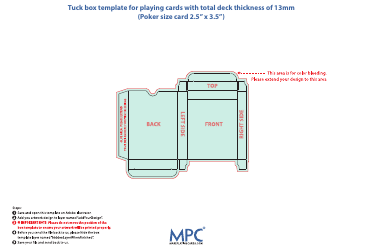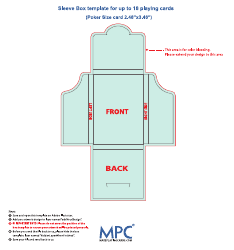Tuck Box Template for Playing Cards With Total Deck Thickness of 25mm
A tuck box template for playing cards with a total deck thickness of 25mm is a design blueprint used for creating a small, protective box in which a deck of cards can be stored. The dimension (25mm) refers to the cumulative thickness of all the cards that will fit into the box. This type of template comes in handy for manufacturers, hobbyists, or playing card enthusiasts who need a precise pattern to create consistent and fitting boxes for a 25mm thick deck of cards. The templates can be transferred onto various materials like cardstock, paperboard, or cardboard which can then be cut out and assembled into a tuck box.
There is no specific information regarding a particular country or individual filing a Tuck Box Template for Playing Cards with a Total Deck Thickness of 25mm. Generally, these templates can be created by anyone, from playing card manufacturers to independent game designers or even individuals who simply enjoy creating their own games or playing card sets. The filing or registration process, if any, would depend on the particular documentation requirements of the country in question - for example, patents or copyright registration in the USA are managed by the US Patent and Trademark Office and Copyright Office respectively.
FAQ
Q: What is a tuck box for playing cards?
A: A tuck box is a standard type of packaging used for playing cards. It's usually made of cardboard and has a flap that you can 'tuck' in to close the box, hence the name tuck box.
Q: How thick is a 25mm deck of cards?
A: A deck of cards with a thickness of 25mm is roughly equal to 1 inch. This size typically comprises around 60 to 75 cards, depending on the cardboard stock used.
Q: What is the standard size of a tuck box for playing cards with total deck thickness of 25mm?
A: A standard tuck box that can accommodate a deck of cards with a 25mm thickness would typically measure around 67mm x 92mm x 25mm. This size suits most poker-sized playing cards.
Q: How can I create a tuck box template for playing cards?
A: You can create a tuck box template for playing cards using graphic design software like Adobe Illustrator, Photoshop, or free tools like Canva. Make sure to include the dimensions specific to the size and thickness of your deck of cards.
Q: What material is best for a playing cards tuck box?
A: Cardboard is the most common material used for playing card tuck boxes. It is durable, easy to print on, and reasonably cost effective. For a more luxury feel, some manufacturers use materials like tin or wood.
















